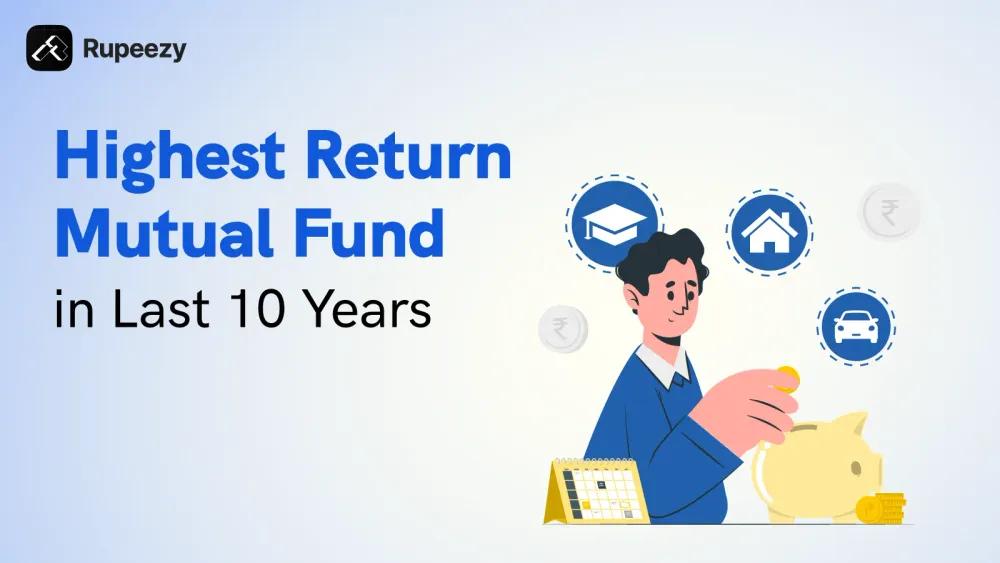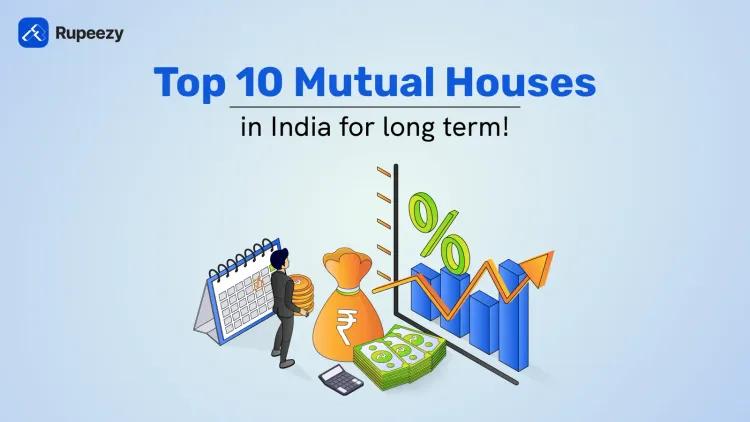Highest Return Mutual Funds in Last 10 Years 2025


00:00 / 00:00
A mutual fund is a proven way to build wealth and achieve long-term financial goals. Certain funds over the last decade have been performing quite well, making them attractive to investors looking at consistent growth.
Here's a look at the highest return mutual fund in last 10 years, along with a brief overview of the top 10 highest return mutual funds in the last decade, comprising their performance and strategies.
Overview of Mutual Funds
A mutual fund gathers the funds of investors to create a well-diversified portfolio managed by professional fund managers. The funds invested across different stocks, bonds, and many other securities have the objective of generating maximum returns.
Highest Return Mutual Fund in Last 10 Years
The list below is curated from the specific categories mentioned in the Rupeezy App. Here is the list of top 10 highest return mutual funds in last 10 years:
Fund Name | 10-year CAGR |
21.88% | |
21.06% | |
20.87% | |
20.38% | |
20.19% | |
20.10% | |
18.96% | |
18.73% | |
18.71% | |
18.71% |
The above information is recorded as of 23/11/2024.
Overview of the Best Mutual Fund with High Returns in 10 Years
1. Nippon India Small Cap Fund
The fund comprises small-cap stocks with 94.77% holdings in Equity, 5.14% in Debt, and 0.09% in Cash. It is being diversified across sectors including Banking, Electric Equipment, Chemicals, Pharmaceuticals, Engineering, Finance & Investments, Auto Ancillaries, Power Generation & Supply, Mining, and others.
AUM (Fund Size): Rs.61,027 Cr
Expense Ratio: 1.43%
Minimum Investment (SIP): Rs.100
Minimum Investment (Lump-sum): Rs.5,000
Risk: Very High
10-Year CAGR: 21.88%
Exit Load: 1% if redeemed within 1 year.
2. SBI Small Cap Fund
The fund comprises small-cap stocks with 88.44% holdings in Equity, 9.68% in Debt, and 1.88% in Cash and others. It is diversified across sectors, including Electric Equipment, Domestic Appliances, Petrochemicals, Banking, Transmission Line Towers, Air Conditioners, Sugar, Abrasives, Textiles, Compressors, and others.
AUM (Fund Size): Rs.33,107 Cr
Expense Ratio: 1.56%
Minimum Investment (SIP): Rs.500
Minimum Investment (Lump-sum): Rs.5,000
Risk: Very High
10-Year CAGR: 21.06%
Exit Load: 1% if redeemed within 1 year.
3. Quant ELSS Tax Saver Fund
The fund primarily consists of large and mid-cap stocks, with 96.18% holdings in Equity, 8.36% in Debt, and -0.13% in Cash and others. It is diversified across sectors, including Refineries, Auto Accessories, Food Processing, Power Generation, Engineering, Pharmaceuticals, Cigarettes, and others.
AUM (Fund Size): Rs.10,980 Cr
Expense Ratio: 1.72%
Minimum Investment (SIP): Rs.500
Minimum Investment (Lumps-sum): Rs.500
Risk: Very High
10-Year CAGR: 20.87%
Exit Load: Nil
4. Quant Small Cap Fund
The fund comprises small-cap stocks with 89.05% holdings in Equity, 10.31% in Debt, and 0.65% in Cash & Others. It is being diversified across sectors including Refineries, Food Processing, Trading, Telecommunication Equipment, Pharmaceuticals, Banking, Entertainment, Healthcare, and others.
AUM (Fund Size): Rs.26,331 Cr
Expense Ratio: 1.60%
Minimum Investment (SIP): Rs.1,000
Minimum Investment (Lump-sum): Rs.5,000
Risk: Very High
10-Year CAGR: 20.38%
Exit Load: 1% if redeemed within 1 year.
5. Motilal Oswal Mid Cap Fund
The fund comprises mid-cap stocks with 97.60% holdings in Equity and 2.40% in Cash & Others. It is being diversified across sectors including Computer Software, Power Cables, Tyres, Healthcare, Electric Equipment, Chemicals, Pharmaceuticals, and others.
AUM (Fund Size): Rs. 20,056 Cr
Expense Ratio: 1.62%
Minimum Investment (SIP): Rs.100
Minimum Investment (Lump-sum): Rs.500
Risk: Very High
10-Year CAGR: 20.19%
Exit Load: 1% if redeemed within 1 year.
6. HSBC Small Cap Fund
The fund comprises small-cap stocks with 98.19% holdings in Equity, 1.91% in Debt, and -0.10% in Cash & Others. It is being diversified across sectors including Textiles, Construction, Finance & Investments, Steel, Power Cables, Petrochemicals, Banking, Auto Ancillaries, and others.
AUM (Fund Size): Rs.16,920 Cr
Expense Ratio: 1.68%
Minimum Investment (SIP): Rs.500
Minimum Investment (Lump-sum): Rs.5,000
Risk: Very High
10-Year CAGR: 20.10%
Exit Load: Nil for up to 10% of units; 1% for excess redemption within 1 year.
7. Axis Small Cap Fund
The fund comprises small-cap stocks with 86.95% holdings in Equity, 11.64% in Debt, and 1.47% in Cash & Others. It is being diversified across sectors including Auto Ancillaries, Air Conditioners, Banking, Cycles & Accessories, Finance & Investments, Construction, Tea, Detergents, Cement, and others.
AUM (Fund Size): Rs.23,952 Cr
Expense Ratio: 1.60%
Minimum Investment (SIP): Rs.100
Minimum Investment (Lump-sum): Rs.100
Risk: Very High
10-Year CAGR: 18.96%
Exit Load: Nil for up to 10% of units; 1% for excess redemption within 1 year.
8. Kotak Emerging Equity Fund
The fund comprises mid-cap stocks with 96.09% holdings in Equity, 3.51% in Debt, and 0.40% in Cash & Others. It is being diversified across sectors including Computer Software, Pharmaceuticals, Auto Ancillaries, Chemicals, Healthcare, Banking, Bearings, Plastic Products, Steel, and others.
AUM (Fund Size): Rs.50,627 Cr
Expense Ratio: 1.43%
Minimum Investment (SIP): Rs.100
Minimum Investment (Lump-sum): Rs.100
Risk: Very High
10-Year CAGR: 18.73%
Exit Load: Nil for up to 10% of units; 1% for excess redemption within 1 year.
9. Kotak Small Cap Fund
The fund comprises small-cap stocks with 97.83% holdings in Equity, 2.29% in Debt, and -0.12% in Cash & Others. It is being diversified across sectors including Steel, Textiles, Auto Ancillaries, Computer Software, Air Conditioners, Abrasives, Detergents, Couriers, Transmission Towers, and others.
AUM (Fund Size): Rs.17,593 Cr
Expense Ratio: 1.64%
Minimum Investment (SIP): Rs.100
Minimum Investment (Lump-sum): Rs.100
Risk: Very High
10-Year CAGR: 18.71%
Exit Load: Nil for up to 10% of units; 1% for excess redemption within 1 year.
10. Edelweiss Mid Cap Fund
The fund comprises mid-cap stocks with 97.11% holdings in Equity, 2.96% in Debt, and -0.07% in Cash & Others. It is being diversified across sectors including Finance & Investments, Electrical Equipment, Pharmaceuticals, Textiles, Computer Software, Banking, Chemicals, Engineering, and others.
AUM (Fund Size): Rs.7,677 Cr
Expense Ratio: 1.74%
Minimum Investment (SIP): Rs.100
Minimum Investment (Lump-sum): Rs.100
Risk: Very High
10-Year CAGR: 18.71%
Exit Load: 1% if redeemed within 90 days.
Why Look at 10 Year Performance?
Consistency Through Market Cycles: The fund records both bull and bear markets during a 10-year time frame. Performance tracking over such cycles gives you an idea of how stable and consistent your fund can be. This long-term perspective will allow you to see if the fund is versatile.
Wealth Accumulation Over Time: Equity funds, in particular, are long-term wealth-generating funds. And when you hold mutual funds for a decade, you are allowing your investments to benefit from that compounding power, which creates wealth over time. Staying invested for a decade also helps you understand market ups and downs, and your money has a better chance of growing in value.
Assessing Risk: Monitoring the fund's performance over 10 years can also reveal risks. One can test how volatile the fund has been and check whether the returns earned would justify the level of risk it takes.
Benchmark Comparison: Comparison of the fund's return against the benchmark or peers over 10 years gives one an idea of its overall performance in the broader context of the market. It can reveal how competitive the fund is in the category.
Factors Influencing Long Term Returns
When investing in mutual funds, several factors can significantly impact their performance:
Performance of Underlying Securities: It is the performance of the assets within the fund, such as stocks, bonds, and commodities, that directly influence returns from the fund. When the underlying assets perform well, the value of the fund rises, and vice versa.
Skills of the Fund Manager: The art of dealing with market fluctuations, allocation of assets, and making an appropriate portfolio has a direct influence on the achievement of a fund. A skillful manager is significant for long-term success.
Sector / Industry Changes: Sector and industry-specific funds can be affected by changes in their respective sectors or industries, which may arise from shifts in regulations, advancements in technology, and evolving market trends. These dynamics can both positively and negatively influence funds focused on particular sectors or industries.
Expense Ratio: The higher the expense ratio, the more fees are deducted from the returns of the fund. A low expense ratio helps maximize the investor's returns over time.
How to Choose the Best Mutual Funds for Long Term Returns
In choosing the best mutual funds based on long-term returns, several key factors should be considered. They are:
Returns: Historical returns over 5 years are crucial when comparing mutual funds. This could help the investor get an idea of how the fund has performed compared to broad market indices and benchmarks. Consistent and strong returns over a longer period generally indicate that the fund is managed well.
Risk-Adjusted Returns: Metrics such as Sharpe’s ratio, are significant in determining how much risk a fund took to earn its returns. The more favorable the ratio, the better the return relative to the risk taken.
Asset Under Management (AUM): A fund with a large AUM can't be as flexible as a smaller one. Larger AUM means better liquidity and stability, large funds can struggle to make flexible investment decisions. On the other hand, a fund with a very small AUM may face liquidity issues and higher expenses, which can limit potential returns.
Expense Ratio: The expense ratio is the annual cost charged on your total portfolio by the fund house for managing the fund. The lower the expense ratio better the returns. Regulatory authority SEBI has a maximum permissible expense ratio for the funds.
Alpha and Beta: Alpha is a measure of how well a fund outperforms its benchmark index, adjusting to risk. If alpha is positive it means that the fund has outperformed the benchmark. Beta on the other hand measures the fund's sensitivity to market movements. A beta higher than 1 means the fund is volatile and therefore carries more risk.
Turnover Ratio: This is a measure of how often the fund buys and sells securities. A higher turnover ratio can lead to higher transaction costs and taxes as well, which can adversely affect overall return. Lower turnover generally indicates a more stable long-term approach to investing.
Risks Associated with Highest Return Mutual Funds
Investing in the highest return mutual funds in India over the past 10 years carries several risks that investors must be aware of:
Market Risk: A movement in the market will cause the value of your money to increase or fall. While choosing the right mutual fund can help mitigate some of this risk, it cannot be eliminated completely. Factors like economic downturns, political instability, or global events can affect market performance.
Interest Rate Risk: Debt mutual funds, which invest in bonds or other fixed-income securities, are sensitive to interest rates. When interest rates rise, the value of the bonds in the portfolio could decline and reduce the returns of the fund, even if it has been one of the best performers over the last 10 years.
Credit Risk: Debt funds are highly vulnerable to the risk that the issuer of the bonds fails to meet their obligations - either in the form of non-payment of interest or non-repayment of principal. This is a risk even to those high-return mutual funds, especially if they invest in bonds issued by relatively less creditworthy companies.
Currency Risk: The primary risk in investing in an international mutual fund or a fund that invests in foreign assets arises from the change in exchange rates. If the currency of the country where the fund is being invested becomes weaker compared to the Indian Rupee, the investment value in terms of rupees would decline.
Liquidity Risk: Some of the best mutual funds will invest in assets that are not easily sold or traded in the market to traders, such as small-cap stocks or private equity. When such investments are made, it could be tough to exit these funds which cause a significant decline in the fund's value.
Inflation Risk: Even though a mutual fund may have performed well, inflation can destroy the real buying power of your gains. So while inflation can outpace the nominal gains of the funds, your investment's purchasing power will be adversely affected over time.
Management Risk: The performance of a mutual fund is heavily dependent upon the ability and experience of the fund manager. A change in the management team or strategy can truly impact the performance of the fund.
Steps to Invest in High Return Mutual Funds
Identify your risk tolerance and financial goals:
You might be saving for -
Marriage
Your child's college education
A house down payment
Retirement
You might determine your risk tolerance once you decide on your goal.
Choose the Right Kind of Funds:
There are diverse kinds of mutual funds (Debt funds, Equity Funds, Hybrid funds, etc) each with a specific risk profile and investment focus. You can compare funds and choose as per your investment goals.
Here’s a simple step-by-step guide to getting started with mutual fund investments through Rupeezy:
Download Rupeezy App: Begin by downloading the Rupeezy app from the Google Play Store / Apple App Store to kickstart your investment journey.
Visit Website: After downloading the app, you’ll be redirected to Rupeezy’s official website where you’ll begin the account setup process.
Fill in Personal Details: Enter your personal details, including your name, address, PAN number, and contact information. Be sure to double-check your details before proceeding.
Upload Documents: To complete your KYC process upload the necessary documents like your Aadhar card, PAN card, and bank statements.
eSign the Form: Once your documents are verified, sign the application form electronically to move forward with the account creation.
Set the Password: After receiving your client code, set up a secure password for your account to keep your data and activity safe.
Start SIP or Lump Sum Investment: Begin with a minimum SIP of ?100 or invest a lump sum as per your financial goals.
Track Performance: Monitor your portfolio regularly using Rupeezy's user-friendly interface.
Long Term Tax Implications on Mutual Funds
As the above-mentioned mutual funds are based on 10-year returns, a long-term capital gain tax is imposed on these funds. This section explains the taxation on long-term capital gains for mutual fund investments, categorized into equity-based, debt-based, and hybrid funds.
Equity Mutual Funds
Long-Term Capital Gains (LTCG)
Holding Period: More than 12 months.
Tax-Free Limit: Gains up to Rs. 1.25 lakh per year are exempted from tax as per section 112A of the Income Tax Act, 1961.
Tax Rate:
Gains exceeding Rs. 1.25 lakh sold after or on 23rd July 2024: 12.5%
Gains exceeding Rs. 1.25 lakh sold before 23rd July 2024: 10%
Debt Mutual Funds
Long-Term Capital Gains (LTCG)
Investments Made Before April 1, 2023:
If Sold Before 23rd July 2024: Gains from units held for more than 36 months are taxed at 20% with indexation benefits.
If Sold On or After 23rd July 2024: Gains from units held for more than 24 months are taxed at 12.5% (no indexation benefit).
Investments Made After April 1, 2023:
Gains are added to your income and taxed at your applicable income tax slab rate, regardless of the holding period.
Hybrid Mutual Funds
Long-Term Capital Gains (LTCG)
Tax Rate:
If Sold Before 23rd July 2024: Gains from units held for more than 36 months are taxed at 20% with indexation benefits.
If Sold On or After 23rd July 2024: Gains from units held for more than 24 months are taxed at 12.5% (no indexation benefit).
Here, the date of investment is not considered; only the sale date of hybrid funds is relevant for tax implications. For more information regarding taxation on mutual funds refer to our detailed article “Tax on Mutual Funds”
Conclusion
Investing in the highest return-yielding mutual funds over the last 10 years can significantly enhance your portfolio's growth. Key factors to consider while selecting these funds include historical performance, asset management size, and fund management expertise. While equity mutual funds have proven to be the most lucrative, it’s important to weigh risks like market volatility, interest rate fluctuations, and liquidity issues. By focusing on these core factors and diversifying across various asset classes, you can make informed choices that align with your long-term financial goals.
Check Out These Related Articles |
The content on this blog is for educational purposes only and should not be considered investment advice. While we strive for accuracy, some information may contain errors or delays in updates.
Mentions of stocks or investment products are solely for informational purposes and do not constitute recommendations. Investors should conduct their own research before making any decisions.
Investing in financial markets are subject to market risks, and past performance does not guarantee future results. It is advisable to consult a qualified financial professional, review official documents, and verify information independently before making investment decisions.

All Category









